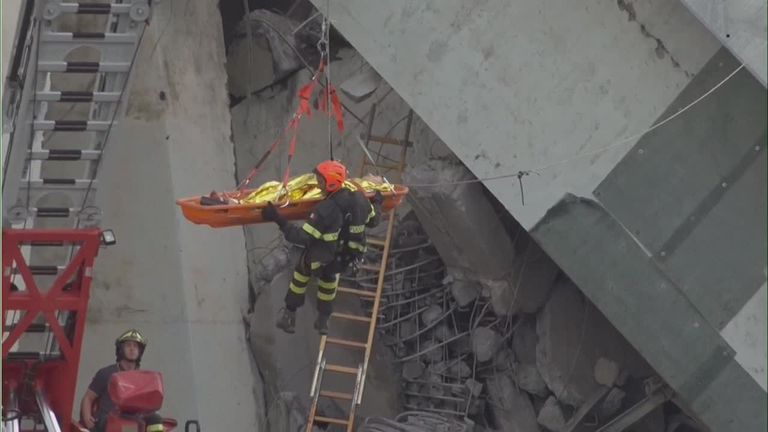Bridge tragedy is an economic disaster in the making
As dozens die and emergency services search for survivors, Nicholas Walton talks about why Genoa is a hostage to its geography.
Wednesday 15 August 2018 12:35, UK
Believed to have been caused by structural weakness, the collapse of the Morandi Bridge in the Italian city of Genoa is a tragedy that will haunt the city for years to come.
As dozens die and emergency services search for people who are trapped, Nicholas Walton, author of Genoa, La Superba: The Rise And Fall Of A Merchant Pirate Superpower, talks about his experience of the viaduct, and why Genoa is a hostage to its geography:
My first experience of the Morandi Bridge was when I went to visit the Genoese family who became my in-laws, 10 years ago.
My then-girlfriend's father picked us up at the airport in his asthmatic Lancia, before we dodged in and out of traffic, through tunnels and over the enormous kilometre-long Morandi viaduct, before descending into the maelstrom of Genoa's chaotic medieval centre.
It was at that point that I fell in love with the extraordinary and harsh geography that makes the city so atmospheric, and the rest of the Ligurian coast so beautiful.
As the Morandi collapse illustrates, however, geography is a curse as much as a blessing.
Genoa, more than any other city I know, is hostage to its geography.
Behind it sits a rim of forbidding mountains, squashing Liguria into the sea and leaving scant room for the farmland or industry that bless Turin or Milan.
Instead, its people always looked to the sea, and the land became famous for breeding tough explorers and adventurers like Christopher Columbus and Giuseppe Garibaldi.
Genoa itself scrabbles for space, and its road links to the outside world rely heavily on engineering feats of tunnelling and bridge-building that were largely completed in the 1960s and 70s, at the height of Italy's post-war economic boom.
Between Genoa and the French border alone there are over 100 motorway tunnels, and countless bridges and viaducts.
The half-century-old Morandi viaduct was one of the most prominent of these, linking the city centre to the outside world.
It was designed by Riccardo Morandi, who made his name pushing the physical and aesthetic limits of pre-stressed concrete.
On my frequent visits to the city, including one just this July, the infrastructure that connects Genoa to the outside world has seemed increasingly creaky and shabby.
The frenetic motorway traffic is often interrupted by workmen who seem to be doing endless patching-up jobs, perhaps illustrating the limits of Italy's public finances.
The economic situation, however, will surely now get worse.
The viaduct was a critical link for Genoa.
Anybody arriving at the airport needed it - or a wriggly and congested urban street - to get into the city centre.
Tourists needed it to reach their cruise ships, or the glories of Portofino and the Cinque Terre, further east along the Ligurian Riviera. Morandi also sits at the motorway junction that heads up in the mountains towards Milan, and its concrete blocks have surely severed all rail links to Turin and Milan for a while.
Those great manufacturing centres will also be cut off from their main port.
This tragedy is an economic disaster in the making.
If I am being hopeful, I can imagine that the Morandi viaduct's collapse will lead to such an outpouring of anger and indignation that local and national politics will finally be forced to change.
But it could go the other way, with the Genoese losing all faith in the other vital pieces of concrete that they rely upon so much.
This would be a calamity, and ensure that this horrible tragedy is one of the grimmest recent events in the history of one of Italy's most extraordinary cities.






